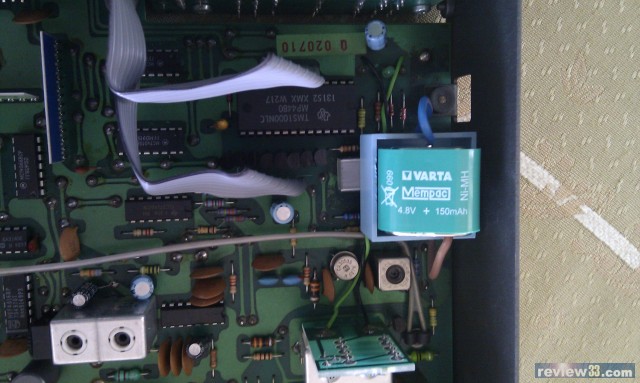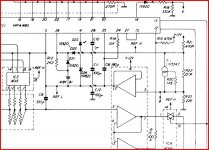Absolutely correct, which is why I think changing those caps has effected the IF filter.
Those caps are not part of the tuned circuits... sorry. Your description of it is fine, but these are not those critical parts.
The 10.7 MHz filter is located at the input to the chip (probably a ceramic type filter) and the IF amplifier is critically tuned via the components connected to pins 9 and 10.
Have you another FM radio? tune this to the station you are listening to and see if it has the same noise if not then your antenna is OK.
Different receivers have different sensitivities and different noise rejection characteristics.
Tried all sort of combination, with old caps, exotic caps, etc for band pass filter portion, results the same sort of whistling noise still there.
Next attempt is to bring it to another location to test 🙂
Next attempt is to bring it to another location to test 🙂
Next attempt is to bring it to another location to test 🙂
Its got to be done 🙂
Just studied the Quad service manaul. There's a Birdie filter formed by C32 RV5 L16 C36 supposedly to suppress extra unwanted noise/tone prior stereo decorder...
Woah, quad fm4 tuner noise problem solved. Culprit was C11 and C12 capacitors. Seems like quad specifically chose some caps that suit its purpose, dadaelectronic has another guy change these caps to Nichicon bipolar cause high pitch hiss. Swap back these two old caps, I'm getting dead clean stereo sound without a hiss!!
I'm damn lucky !!
I'm damn lucky !!
Well thats great. I see those caps are marked as non polarised even though they are a 100uf. Now those caps would have been interesting to put a scope on and see just what was there.
Well done 🙂
Well done 🙂
I'm wondering too. Would it be because those caps are matched pair?
Now I've another problem, I bought another FM4 which is on the way to me from the UK.... 🙂
Now I've another problem, I bought another FM4 which is on the way to me from the UK.... 🙂
Would be very interested if someone has Fm4 and oscilloscope can make an effort to probe the c11 and c12 ?
Why recapping them could cause the high pitch noise..
Why recapping them could cause the high pitch noise..
My guess would be that the caps had high self inductance at hf that limited their effectiveness. Bypassing them with a 0.1uf and series 1 ohm might have done the trick.Why recapping them could cause the high pitch noise..
Edit... its actually quite interesting to have a real world example of where a supposed new and better part causes a problem and just goes to show that sometimes blanket re-caps and "upgrading" of parts should be done with care.
Yes Mooly, it's interesting to learn this lesson.
I'm learning towards Magnum Dynalab ST-2 aerial. Wondering if it's effective since I'm already getting strong signal using indoor dipole aerial (a piece of T wire...)?
I'm learning towards Magnum Dynalab ST-2 aerial. Wondering if it's effective since I'm already getting strong signal using indoor dipole aerial (a piece of T wire...)?
Well you can never have to much signal (up to a point). If the stations you listen to really do have a silent interference free background on the aerial you use now, then you can't make that any better. Only you can answer this one I'm afraid.
Some opamps tend to oscillate at capacitive loading. This might have happened with the TL094 and the signal modulated RefL that caused FM modulation of the local osc - all this due to too good capacitors... Probably a series 47R resistor at IC5 pin1 output could have also prevented it.My guess would be that the caps had high self inductance at hf that limited their effectiveness. Bypassing them with a 0.1uf and series 1 ohm might have done the trick.
Edit... its actually quite interesting to have a real world example of where a supposed new and better part causes a problem and just goes to show that sometimes blanket re-caps and "upgrading" of parts should be done with care.
Some opamps tend to oscillate at capacitive loading. This might have happened with the TL094 and the signal modulated RefL that caused FM modulation of the local osc - all this due to too good capacitors... Probably a series 47R resistor at IC5 pin1 output could have also prevented it.
Good point. Yes it could have been something like at work too.
Guys, I just tried Magnum Dynalab ST-2 and sold it right after an hour. Cant seem to get it work better than my dipole aerial in my living hall. I've to tilt it to an odd position to get good reception.
Prehaps like Mooly mention, I cannot get more signal than I already getting 🙂
Prehaps like Mooly mention, I cannot get more signal than I already getting 🙂
The "better" an aerial (the more elements it has) then the more directional it becomes. If you are in a building with lots of walls either side of you, then maybe you are getting lots of reflections of the signal.
If you have found something that works OK for you then stick to it.
If you have found something that works OK for you then stick to it.
I found a relevant web page:
FM Antennas
I am using a "turnstile" antenna on the roof, and I can receive stations from about 25 km distance.
FM Antennas
I am using a "turnstile" antenna on the roof, and I can receive stations from about 25 km distance.
What an excellent thread.
I had this issue occur with an FM4 I'd recently serviced and have been scratching my head for the cause. The TL094 does indeed require a capacitor to ground with some appreciable ESR, unlike the Panasonic FC I'd fitted.
You can use a slightly lossy bi-polar, or as in my case a tantalum works perfectly in this position. There's about 1.8v dc across C11 and 6v across C12. A 10v tantalum is therefore recommended.
I had this issue occur with an FM4 I'd recently serviced and have been scratching my head for the cause. The TL094 does indeed require a capacitor to ground with some appreciable ESR, unlike the Panasonic FC I'd fitted.
You can use a slightly lossy bi-polar, or as in my case a tantalum works perfectly in this position. There's about 1.8v dc across C11 and 6v across C12. A 10v tantalum is therefore recommended.
I'm glad that this thread helps to pinpoint and resolve your issue. I noticed that Quad has different sub board fitted to replace a diode near C11.
One look like this

The other one looks like this:

From what I gathered, the board is meant to increase stability of tuning.
I'm having my third FM4 shipping from the UK. It's very late production model with orange color Quad wording and Q038xxx serial, probably the last few before it gets discontinued.
Wondering if there's any circuit changes with later version, lets see.
One look like this

The other one looks like this:

From what I gathered, the board is meant to increase stability of tuning.
I'm having my third FM4 shipping from the UK. It's very late production model with orange color Quad wording and Q038xxx serial, probably the last few before it gets discontinued.
Wondering if there's any circuit changes with later version, lets see.
- Home
- Source & Line
- Analogue Source
- HELP: QUAD FM4 Tuner Background Noise/High Pitch Hiss
